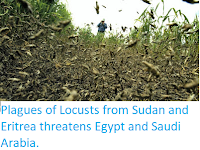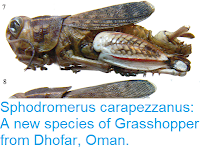Pygmy Grasshoppers (Tetrigidae) are small Orthopteran Insects related to
True Grasshoppers, Crickets and Katydids, found across much of the
globe but most numerous and diverse in the tropics. The name ‘Pygmy
Grasshoppes’ is somewhat misleading, as they seldom feed on Grass,
instead mainly consuming Bryophytes (Mosses), Algae, Lichens and only
the occasional small vascular plant; the group are also known as Grouse
Locusts or Ground Hoppers. Surprisingly for Orthopterans, many species
are capable swimmers, and live semi-aquatic lifestyles. They are a large
group today, with over 1700 described species, however their fossil
record is rather limited, with only eleven fossil species described to date.
In a new paper published in the journal Zootaxa on 16 August 2019, Jared Thomas of the Center for Paleontology at the University of Illinois at Urbana-Champaign, Josip Skejo of the Evolution Lab at the University of Zagreb, and the Institute for Molecular Evolution at Heinrich-Heine University Düsseldorf, and Sam Heads, also of the Center for Paleontology at the University of Illinois at Urbana-Champaign, describe a new species of Pygmy Grasshopper from Eocene Baltic Amber.
Baltic amber is the preserved resin of Eocene Coniferous Trees that
formed huge forests covering much of Scandinavia and Northern Europe between about 56 and 34 million years ago.
Since this amber floats, it is often found on beaches around the Baltic Sea,
and sometimes further afield, making the precise dating of individual
pieces difficult, though most Baltic Amber is thought to be about 46 million years old.
The new species is named Danatettix hoffeinsorum, where 'Danatettix' means 'Dana's Grasshopper' in honour of Katie Dana, the wife of Jared Thomas, for stimulating his interest in Insects, and 'hoffeinsorum' honours Christel and Hans Hoffeins for their efforts in collecting Baltic Amber; the specimens from which the species is described come from the Hoffeins' collection, but will be donated to the Senckenberg Deutsches Entomologisches Institut in Müncheberg. The new species is described from three specimens, an adult female and two nymphal (immature) males.
Dorsal oblique view adult female Danatettix hoffeinsorum. (1) Photograph. (2) Line drawing. Scale bars are 1 mm. Thomas et al. (2019).
The anterior (front) margin of the pronotum (plate that covers the back of the thorax) is truncated in Danatettix hoffeinsorum, a trait seen in members of the living genera Paurotarsus and Eutettigidea, which are found in Central and South America. This is interesting because like them Danatettix hoffeinsorum appears to be a member of the subfamily Batrachideinae, which today is found in the Americas, Africa, Australia, and parts of tropical Asia, but not Europe. This suggests that the subfamily was more widely distributed in the past.
Left lateral image of early instar male nymph of Danatettix hoffeinsorum. (9) Photograph. (10) Line drawing. Scale bars are 1 mm. Thomas et al. (2019).
See also...
Follow Sciency Thoughts on Facebook.








